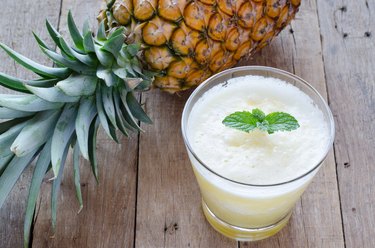
Your body, especially your brain, depends on a consistent level of blood sugar. Things can go awry when the amount of sugar in your blood is outside of the normal range.
A sugar crash is when your blood glucose drops below normal. It occurs in people with diabetes, as well as those who don't have diabetes. When this happens, the goal is to bring your blood sugar back into the normal range as quickly as possible.
Video of the Day
Video of the Day
Symptoms and Causes
Your blood sugar is low when it falls below 70 milligrams per deciliter, according to the Joslin Diabetes Center. When your blood glucose crashes, you may feel weak, irritable, sweaty, shaky and hungry, or experience a rapid heart rate or headache.
If you have diabetes, skipping meals or taking too much medication can cause low blood sugar. In people who don't have diabetes, poor diet, drinking too much alcohol, eating highly refined carbohydrates, intense exercise, certain illnesses and certain medications can cause low blood sugar.
Reactive hypoglycemia is also a potential cause of sugar crashes, according to the Mayo Clinic. If you have this condition, you may experience a sugar crash within four hours after eating a meal. Symptoms of reactive hypoglycemia include shakiness, sweating, fatigue or anxiety.
Doctors aren't always sure what causes reactive hypoglycemia. If you're experiencing low blood sugar symptoms after eating, you should consult with your doctor.
Reversing a Sugar Crash
When your blood sugar crashes, you can quickly bring it back up to normal. You need a rapidly absorbing form of carbohydrate, also known as a simple carb. Eating 15 to 30 grams of fast-digesting carbs is often enough to quickly reverse a sugar crash.
These each represent 15 grams of simple carbohydrates: half a banana; 1/2 cup of apple sauce; 1/2 cup of apple, orange or pineapple juice; six large jelly beans; or five small gum drops.
For People With Diabetes
Check your blood sugar when you start to experience symptoms. If it's below 70 milligrams per deciliter, eat 15 to 30 grams of fast-absorbing carbohydrates. Wait 15 minutes, then recheck your blood glucose level.
If your reading is below 100 milligrams per deciliter, eat another 15 grams of quick-absorbing carbohydrates. After waiting another 15 minutes, recheck to see if it's within the target range your doctor outlined for you. Repeat these steps if necessary.
Managing Blood Sugar Crashes
If you're prone to low blood glucose, it's a good idea to carry a source of fast-absorbing carbs with you. Follow up with your doctor and take a glucose tolerance test if this is your first episode and you don't have diabetes.
Read more: The Best Diet for Reactive Hypoglycemia
In the meantime, eat small, frequent meals rather than fewer large meals filled with a mix of healthy, nutrient-rich foods. If you have diabetes, talk to your doctor about the best way to prevent low blood sugar. He may adjust your medication or recommend making dietary changes to keep your blood more stable, such as eating high-protein snacks between meals.